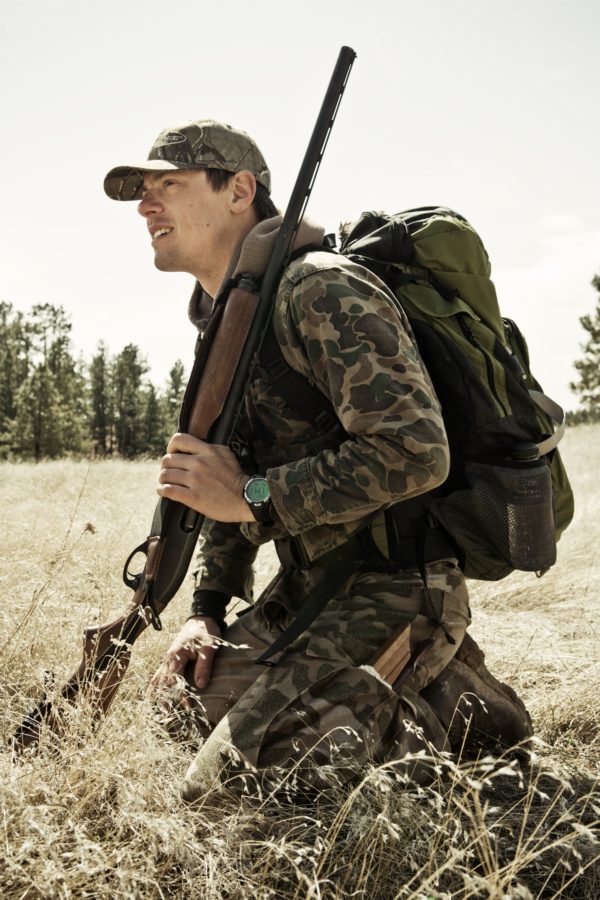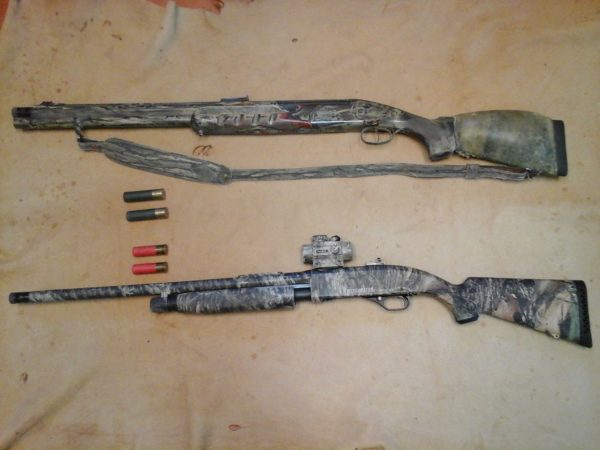
Rigging up a turkey gun can be as simple or as complicated as you want to make it. For an experienced shooter who limits his shots to 30 or so yards, all you need is your standard 12-gauge shotgun with a modified or full choke and some quality turkey loads.
If you want a gun that’s suitable for long hikes and long shots, a few simple modifications can turn your rabbit and grouse gun into a souped-up turkey rig.
On top, an inexpensive Italian-made break-action over/under shotgun with $800 worth of custom work that turned it into a turkey-specific shotgun. Modifications included polished and lengthened force cones, custom chokes, soldered rifle sights, an elk-leather cheek pad, camouflage paint, and a comfortable sling. On the bottom a Winchester model 1100 pump with a TruGlo red dot scope and an all-weather camo coating.
Turkey chokes
There are many aftermarket turkey chokes on the market. The tight restrictions on these chokes can give you a lot of extra distance, but keep in mind that a tight pattern at long distances means a very tight pattern at short distances.
A turkey choke might give you what you need to pepper a bird’s head at sixty yards, but it opens up the possibility of missing at ten yards if your aim is just an inch or two off. Still, turkey chokes are well worth the cost if your shotgun is threaded for screw-in chokes.
I’ve had excellent luck with the Haymaker choke tube from Down-N-Dirty Outdoors. Just make sure to pattern your shotgun before you hunt turkeys and keep a calm head when aiming.
Sights
With a little practice you can hit turkeys very effectively using nothing but the naked barrel of your shotgun and the front bead. But again, if you’re looking to stretch your shots out to distances of 50 yards and beyond it can be a good idea to fit your shotgun with a better sighting system.
More and more turkey hunters are using scopes and red-dot sights on their turkey guns. Use of such technologies seems excessive in this case and risks complicating something that should be very simple. A better bet is to rig your shotgun with a rifle sight system that includes a front and rear sight that can be mounted to a standard ribbed shotgun barrel. The company TruGlo has a great line of turkey sights that’ll fit most any shotgun.
Turkey barrels
If you got the money, you can solve the issues of chokes and sights with the purchase of a dedicated turkey barrel. Several manufacturers of pump-action and autoloading shotguns produce turkey barrels that can easily be swapped back and forth with your shotgun’s existing all-purpose barrel without the requirement of gunsmithing services .
The upside to turkey barrels is that they are shorter, which makes them easier to carry and handle, and that many come equipped with turkey chokes.
Browning produces a turkey barrel for their excellent BPS pump-action shotgun that comes with both a turkey choke and a quality set of permanently attached rifle sights. A downside is cost.
A turkey barrel for a Browning BPS costs as much as an entire Remington 870 Express shotgun. And a turkey barrel for the 870 will cost you half as much as you paid for the shotgun in the first place.

Slings
Since snap shooting isn’t part of turkey hunting, a sling can be a great addition to your turkey gun. It eliminates arm fatigue from toting your gun all day, and it keeps your hands free for working with turkey calls when you’re traveling in search of mid-morning birds. Most models of shotguns can be fitted with aftermarket sling kits that require little or no permanent alteration of the gun.
Turkey Ammo
A turkey hunter seldom fires more than one or two shots per season, excluding practice sessions, so there’s no need to worry about excessive wear and tear on your shoulder from shooting 3” or even 3 ½” shells. As long as your shotgun is chambered for these magnum rounds, it’s a smart idea to get as much knock-down power as you can from it when gunning for these big birds.
Make sure to stick with dedicated turkey loads. While guys will brag about killing turkeys with nothing but old squirrel loads they inherited from Grandpa, you’re better off using turkey loads from reputable manufacturers. Most shotshells designed for turkeys are loaded with lead pellets that have been plated in copper. The heaviness of the lead yields high velocities, while the copper coating prevents the spheres from deforming in the barrel and flying erratically.
Turkey loads will also have thicker and deeper wads to protect the metal on tight chokes and to deliver denser patterns at long ranges. Even though wild turkeys are often much bigger than geese, you’ll use smaller sized pellets than you would for goose hunting. Size 4, 5, and 6 shot all work well for turkeys, as do “blended” loads that use multiple shot sizes. Some states do not allow shot larger than #4 or smaller than #7 ½ to be used on turkeys, so as always check your local regulations before loading up.
In my opinion, the company Hevi-Shot produces one of the best turkey loads out there. It’s a non-toxic shot that is very expensive but, in my opinion, it’s well worth the cost for turkey hunting. The heaviness of the shot allows you to use smaller pellets, which means more pellets in the shell.
I have had fantastic luck with their Magnum Blend shotshells loaded with 5, 6, and 7 pellets. When using these rounds, I get more than enough pellets into the bird’s head with hardly ever a pellet straying down into the bird’s meat.





